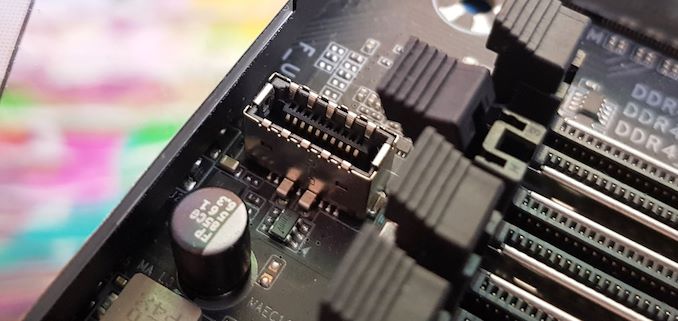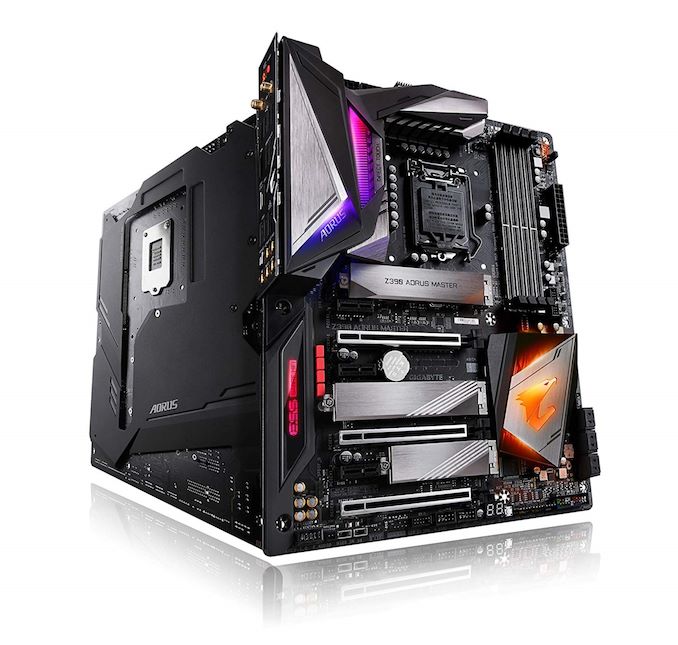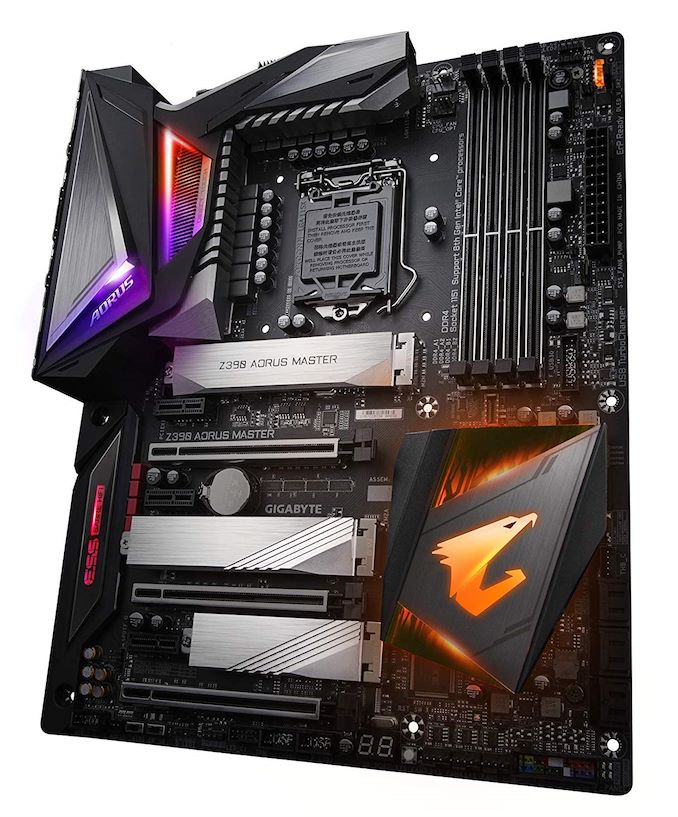The GIGABYTE Z390 Aorus Master Motherboard Review: Solid, But Not Special
by Gavin Bonshor on March 21, 2019 12:30 PM EST- Posted in
- Motherboards
- Intel
- Gigabyte
- ATX
- LGA1151
- i7-8700K
- Z390
- Aorus Master
The $250 to $300 motherboard competition stack is highly contested for Z390, with GIGABYTE, ASRock, MSI, and ASUS all having at least two models each in this segment. Some manufacturers add in 2.5 or 10 GbE NICs into its models in this price range, or extensive USB 3.1 G2 offerings, and it forces the manufacturers to step up. GIGABYTE brings the ATX sized Z390 Aorus Master to the table and while it is an attractive model with plenty of features such as triple M.2 with three individual M.2 heatsinks to use and a pre-attached rear IO shield, GIGABYTE could have equipped the Z390 Aorus Master with a little more.
The performance in our test suite as far as system and CPU testing went proved that the Z390 Aorus Master can hang with the competition in most instances, however there were a few slips, perhaps due to its memory training not being as tight as the competition at stock settings. There were some slightly disappointing results with a mediocre showing in our DPC Latency testing and the results in our game testing seemed to be a couple of percent off the expected mark. For computational tasks, however, the Z390 Aorus Master did well and in our power consumption tests, it seemed quite efficient given our power hungry i7-8700K testbed sample. The performance in our non-UEFI POST time test was also good and competes well against some of the best performers. In our overclocking tests, we did hit a few snags along the way which we generally don't experience. We managed a maximum stable overclock of 5.0 GHz at 1.3 V on the CPU VCore which is good for our Core i7-8700K, but it couldn't go beyond this. To achieve it we had to change a whole host of power related settings as we got crashes at what are usually successful combinations of CPU frequency and CPU Core Voltage. To alleviate the unreliable CPU VCore readings from the CPU-Z utility and GIGABYTE's own EasyTune software, users can download HWINFO and use the VR VOUT reading under the IR35201 section of the utility.
On the rear panel, GIGABYTE does include a total of four USB 3.1 G2 ports (three Type-A, one Type-C), two USB 3.1 G1 compatible with its USB DAC-UP 2 technology and four USB 2.0 ports. Users looking for more can use the front panel headers which include one USB 3.1 G1 Type-A header (two ports), two USB 2.0 headers (four ports) and a single USB 3.1 G2 Type-C header. While the additional Type-C header is welcomed, its placement does seem a little lacklustre given it’s so close to the clasp of the second RAM slot. With the header populated, it would need to be unplugged to remove an installed stick in that slot. Something slightly more disappointing is the Intel I219-V 1 GbE PHY and considering the $290 price tag, I would expect to see a little more in this area; perhaps a 2.5 or 5 GbE NIC to help cement the Z390 Aorus Master as a premium model. There is an Intel 9560 802.11ac MU-MIMO Wi-Fi adapter present which uses the CNVi within the Z390 chipset and it offers users Bluetooth V5 connectivity. Also featured on the rear panel is a handily located clear CMOS button and users can power and reset their system by using the dedicated power switch on the rear.

The clasp of RAM slot two obstructing front panel USB 3.1 G2 Type-C Header
GIGABYTE in previous years has opted to focus a lot of its attention on the audio and the Z390 Aorus Master is no exception to this. The board utilizes the premium Realtek ALC1220 HD audio codec and even includes an ESS Sabre 9118 DAC which features its own integrated headphone amplifier. Users with USB headsets can also use the two USB DAC-UP 2 ports on the rear with the supplied software. This allows users to apply voltage compensation to pump a bit more juice through the cable, although this shouldn’t be too much an issue unless the headset cable is extensively long. Covering the audio PCB is a fancy looking plastic cover, but it doesn’t double up as an EMI shield. On the PCB is five gold audio capacitors and four WIMA capacitors. The only issue is the lack of a dedicated third-party software suite which we’ve seen over the years. Even though the Realtek Audio Console is decent, even giving users some extra software such as the Creative or another alternative would go a long way to giving the user a more premium feel to bolster their overall experience.
Conclusion
With a price tag of $290 its extravagant looks, its solid feature set with a Realtek ALC1220 audio codec, Intel 9560 802.11ac MU-MIMO Wi-Fi and solid power delivery with one of the heatsinks on the Z390 chipset make it attractive. There could be some more focus put on the premium components, but GIGABYTE seemingly put its focus on the onboard audio which they are well known for doing and everything else seems to be on par with the competition. The metal rear PCB brace is a nice touch and expands somewhat upon the premium feature set on offer, but it's not defining aspect to make it the defining board of its price point.
Ultimately, the Z390 Aorus Master is a solidly product, and when overclocked should make a user very happy when going above stock performance, particularly in memory. However, GIGABYTE should trying to stand out from the competition with at least one super feature.












36 Comments
View All Comments
Timur Born - Thursday, March 21, 2019 - link
I have to keep ring ratio below x46 to stay stable overclocked.gavbon - Friday, March 22, 2019 - link
I tested DPC Latency on the latest 2 revisions (F7 and F8e). Retested the full suite on both revisions and didn't notice any significant differences. GIGABYTE has good hardware, just tetchy firmwareTimur Born - Thursday, March 21, 2019 - link
I am confused by the supposed usage of "DPC Latency Checker" on Windows 10?! Do you use LatencyMon or how do you make it work?gavbon - Friday, March 22, 2019 - link
We use LatencyMon :)Timur Born - Saturday, March 23, 2019 - link
I guessed so, which means this is just a typo in the text. Do you report maximum or average latencies and is this using the "Balanced" or "High Performance" Windows power profile?Gasaraki88 - Friday, March 22, 2019 - link
That gaming performance is pretty bad. A difference of 10+ frames between the best and worst board (this one) is a big different when you have the same cpu, gpu, and memory.IndianaKrom - Saturday, March 23, 2019 - link
I have this board and a 9900k, and the gaming performance is nothing like what they are getting in benchmarks (even my 7700k system was doing better than that). I wonder if it isn't because the BIOS defaults for this board actually respect the Intel turbo boost spec and will dial down the CPU clocks/energy back down to the rated TDP after a few seconds of load. I went in to BIOS and deliberately set P1/P2/P3 turbo power states to unlimited watts/duration so my CPU will turbo at its highest possible bins forever as long as the thermals are in check, but if you don't do that the board will clamp the CPU to 115w after 10 seconds and 95w after like 30 seconds IIRC.Arbie - Friday, March 22, 2019 - link
Even if the company's legal name is in all caps, that's just marketing hype and hard on the reader's eyes. I wouldn't indulge them by repeating it - which does them no favors anyway, as it looks gimmicky and cheap.WickedMONK3Y - Monday, March 25, 2019 - link
The performance of this board seems to vary greatly depending on the CPU used, and the BIOS revision that is on the board. F5 and F6 seem to be the best BIOS versions so far, I am running mine with F6 and a 9900K, and stuck in an 8700K to check these numbers and my performance was higher, but my girlfriends PC is running the same board on F8 with a 9700K and when I put in the 8700K the numbers are close to these. Scary how much a BIOS can affect performance on these boards.VoodooRufus - Wednesday, March 27, 2019 - link
Beefy power section, ESS Sabre DAC, gold plated audio connectors, dual 8-pin CPU power, and front USB-C. Very good aesthetics, integrated IO plate. VRM's run cool with minimal airflow. I love my Aorus Master. Stable and easy to tune. I mostly hate my Z68X-UD7-B3 in comparison.